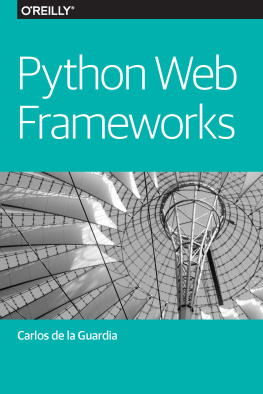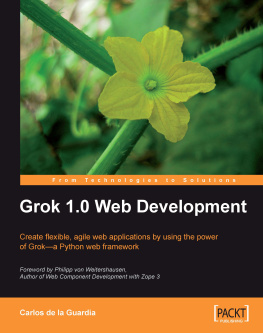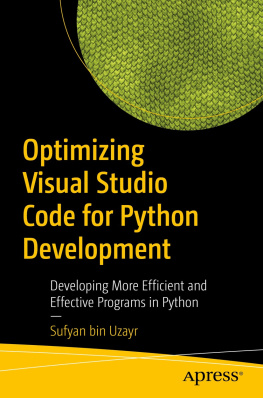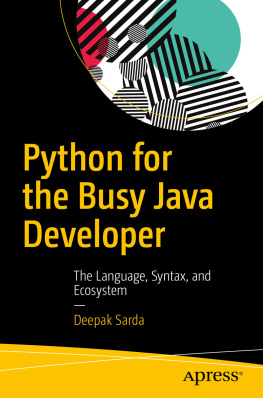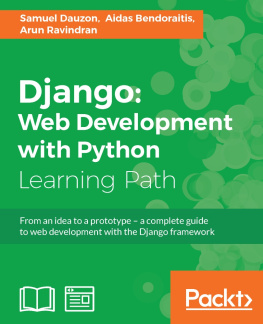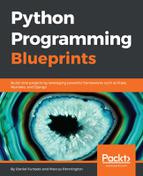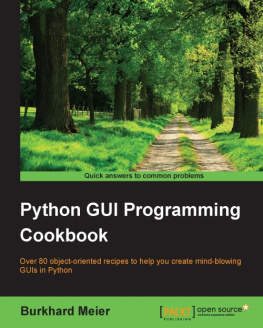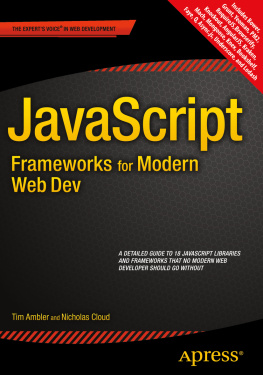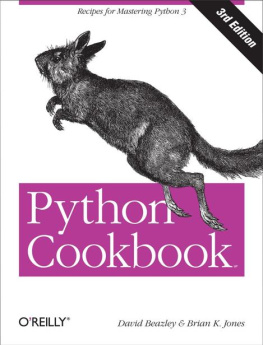Carlos de la Guardia - Python Web Frameworks
Here you can read online Carlos de la Guardia - Python Web Frameworks full text of the book (entire story) in english for free. Download pdf and epub, get meaning, cover and reviews about this ebook. year: 2016, publisher: OReilly Media, genre: Computer. Description of the work, (preface) as well as reviews are available. Best literature library LitArk.com created for fans of good reading and offers a wide selection of genres:
Romance novel
Science fiction
Adventure
Detective
Science
History
Home and family
Prose
Art
Politics
Computer
Non-fiction
Religion
Business
Children
Humor
Choose a favorite category and find really read worthwhile books. Enjoy immersion in the world of imagination, feel the emotions of the characters or learn something new for yourself, make an fascinating discovery.
- Book:Python Web Frameworks
- Author:
- Publisher:OReilly Media
- Genre:
- Year:2016
- Rating:3 / 5
- Favourites:Add to favourites
- Your mark:
- 60
- 1
- 2
- 3
- 4
- 5
Python Web Frameworks: summary, description and annotation
We offer to read an annotation, description, summary or preface (depends on what the author of the book "Python Web Frameworks" wrote himself). If you haven't found the necessary information about the book — write in the comments, we will try to find it.
Python Web Frameworks — read online for free the complete book (whole text) full work
Below is the text of the book, divided by pages. System saving the place of the last page read, allows you to conveniently read the book "Python Web Frameworks" online for free, without having to search again every time where you left off. Put a bookmark, and you can go to the page where you finished reading at any time.
Font size:
Interval:
Bookmark:
by Carlos de la Guardia
Copyright 2016 OReilly Media, Inc. All rights reserved.
Printed in the United States of America.
Published by OReilly Media, Inc. , 1005 Gravenstein Highway North, Sebastopol, CA 95472.
OReilly books may be purchased for educational, business, or sales promotional use. Online editions are also available for most titles (http://safaribooksonline.com). For more information, contact our corporate/institutional sales department: 800-998-9938 or corporate@oreilly.com .
- Editor: Allyson MacDonald
- Production Editor: Shiny Kalapurakkel
- Copyeditor: Gillian McGarvey
- Proofreader: Charles Roumeliotis
- Interior Designer: David Futato
- Cover Designer: Karen Montgomery
- February 2016: First Edition
- 2016-02-12: First Release
The OReilly logo is a registered trademark of OReilly Media, Inc. Python Web Frameworks, the cover image, and related trade dress are trademarks of OReilly Media, Inc.
While the publisher and the author have used good faith efforts to ensure that the information and instructions contained in this work are accurate, the publisher and the author disclaim all responsibility for errors or omissions, including without limitation responsibility for damages resulting from the use of or reliance on this work. Use of the information and instructions contained in this work is at your own risk. If any code samples or other technology this work contains or describes is subject to open source licenses or the intellectual property rights of others, it is your responsibility to ensure that your use thereof complies with such licenses and/or rights.
978-1-491-93810-2
[LSI]
At the time of this writing, the web development landscape is dominated by JavaScript tools. Frameworks like ReactJS and AngularJS are very popular, and many things that were previously done on the server are handled on the client side by these frameworks. This is not limited to the client. Server-side JavaScript frameworks like NodeJS are also prominent.
Does that mean that languages like Python should throw in the towel andforget about web applications? On the contrary. Python is a very powerful language that is easy to learn and provides a fast development pace. It has many mature libraries for web-related tasks, from object-relational mapping (ORM) to web scraping. Python is also a fabulous glue language for making disparate technologies work together. In this era where JSON APIs and communication with multiple systems are so important, Python is a great choice for server-side web development. And its great for full-scale web applications, too!
There are many web frameworks for Python; some provide more facilities than others, some offer a greater degree of flexibility or more extensibility. Some try to provide everything you need for a web application and require the use of very specific components, whereas others focus on giving you the bare minimum so that you can pick only the components your application needs.
Among these frameworks, there are dozens that have a significant number of users. How do newcomers to the language choose the right one for their needs? The easiest criterion would probably be popularity, and there are two or three frameworks that will easily be found doing web searches or asking around. This is far from ideal, however, and leaves the possibility of overlooking a framework that is better suited to a developers needs, tastes, or philosophy.
In this report, we will survey the Python web framework landscape, giving aspiring web developers a place to start their selection process for a web framework. We will look in some detail at a few of the available frameworks, as well as give pointers about how to pick one, and even how to go about creating your own.
Hopefully, this will make it easier for new developers to find whats available, and maybe give experienced Python developers an idea or two about how other web frameworks do things.
A web application is not a standalone program but part of the web pipeline that brings a website to a users browser. Theres much more to it than your application code working under the hood to make the web work, and having a good understanding of the other pieces of the puzzle is key to being a good web developer. In case you are new to web development or need a refresher, take a look at to get your bearings.
When writing a web application, in addition to writing the code that does the business logic work, its necessary to figure out things like which URL runs which code, plus take care of things like security, sessions, and sending back attractive and functional HTML pages. For a web service, perhaps we need a JSON rendering of the response instead of an HTML page. Or we might require both.
No matter what our application does, these are parts of it that very conceivably could be used in other, completely different applications. This is what a web framework is: a set of features that are common to a wide range of web applications.
Exactly which set of features a framework provides can vary a lot among frameworks. Some frameworks offer a lot of functionality, including URL routing, HTML templating systems, ORMs to interact with relational databases, security, sessions, form generation, and more. These are sometimes referred to as full-stack frameworks.
Other frameworks, known by many as micro frameworks, offer a much less varied set of features and focus on simplicity. They usually offer URL routing, templating, and not much else.
This emphasis on size (micro and full-stack) can sometimes be confusing. Are we referring to the frameworks codebase? Are micro frameworks for small applications and full-stack frameworks for large applications? Also, not all frameworks easily fit into one of these categories. If a framework has lots of features but makes most of them optional, does that still count as full-stack?
From an experienced developer point of view, it could make sense to examine frameworks in terms of decisions made. Many features offered by frameworks, like which ORM it supports or which templating system its bundled with, imply a decision to use that specific tool instead of other similar components.
Obviously, the more decisions made by the framework, the less decisions the developer needs to make. That means more reliance on the way the framework works, more knowledge of how its parts fit together, and more integrated behaviorall within the confines of what the web framework considers a web application. Conversely, if a developer needs to make more decisions, theyll have more work to do, but they will also have more control over their application, and can concentrate on the parts of a framework they specifically need.
Even if the framework makes these decisions, most of them are not set in stone. A developer can change these decisions, maybe by replacing certain components or libraries. The trade-off is losing some framework functionality in return for that freedom.
There are many Python web frameworks. Besides size and decisions made for the developer, many of them offer unique features or special twists on what a web appplication should do. Some developers will immediately feel attracted to some frameworks, or conclude after some analysis that one of them is better suited for the specific project they have in mind. Regardless of the chosen framework, its always a good idea to be aware of the variety of other available frameworks so that a better choice can be made if necessary.
Font size:
Interval:
Bookmark:
Similar books «Python Web Frameworks»
Look at similar books to Python Web Frameworks. We have selected literature similar in name and meaning in the hope of providing readers with more options to find new, interesting, not yet read works.
Discussion, reviews of the book Python Web Frameworks and just readers' own opinions. Leave your comments, write what you think about the work, its meaning or the main characters. Specify what exactly you liked and what you didn't like, and why you think so.

